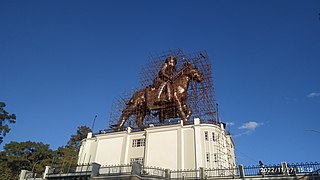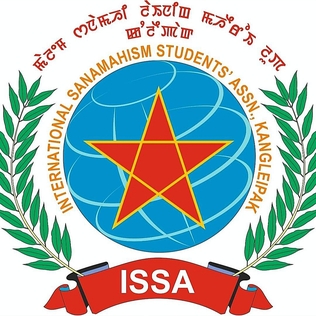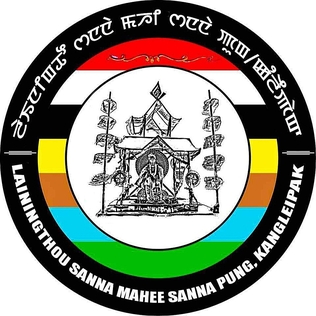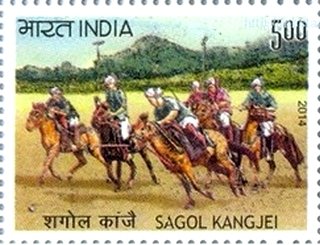
The Meitei script, also known as the Kanglei script or the Kok Sam Lai script, after its first three letters is an abugida in the Brahmic scripts family used to write the Meitei language, the official language of Manipur and one of the 22 official languages of India. It is first known from engravings on 6th century AD coins. as verified by the various publications of the National Sahitya Akademi. It was used until the 18th century, when it was replaced by the Bengali alphabet. A few manuscripts survive. In the 20th century, the script was revived and is again being used. Beginning in 2021, the Government of Manipur began to use the Meitei alongside the Bengali-Assamese script, per the Manipur Official Language (Amendment) Act, 2021.

Meitei literature, also known as Manipuri literature, is literature written in the Meitei language of Manipur. An ancient institution of learning, the Luwang Nonghumsang, later known as the Pandit Loishang, collected sources of indigenous Meitei knowledge and philosophy until the 18th century. Writing by Meiteis is assumed to go back to the Kingdom of Kangleipak in the early 12th century. The Meitei script is a Brahmic abugida. It is known only from the Puya manuscripts discovered in the first half of the 20th century. Manuscripts of the 18th and 19th centuries were written using the Bengali alphabet. The existence of the Meitei script in the 15th-century hinges on the authenticity of an inscription dated to the reign of Senbi Kiyamba. The first printed Manipuri book, Manipurer Itihas, appeared in 1890 from the Baptist Mission Press, Calcutta. Though the kings of Manipur had established contact with the British from the middle of the eighteenth century onward the real impact of the contact came much later. Johnstone Middle English School, based on the western system of education, was started in 1885 at Imphal, and in 1891 Manipur lost its independence to the British. British domination facilitated the introduction of new systems in the civil, political and educational spheres, which hastened the process of modernization in Manipur, exposed as it was to new ideas and influences.

Meitei architecture, sometimes also referred to as Manipuri architecture, is the architecture produced by the Meitei speaking people, whose culture flourished in the Kangleipak kingdom and its neighbouring kingdoms from the middle of the fifteenth century BC. The Meitei architecture is best known for its temples, found scattered in the Kangleipak. Other architectural forms that are still in existence are the grand gates (Hojang), Traditional houses (Yumjao), Public houses (Sanglen), Official buildings (Loishang), etc.
The Meitei calendar or the Manipuri calendar or the Kangleipak calendar or the Maliyapham Palcha Kumshing is a lunar calendar used by the Meitei people of Manipur for their religious, agricultural and other cultural activities. New moon is counted as the end of each month and has twelve months in total. The concept of era in Meitei calendar was first developed by Emperor Maliyafam Palcha, in the year 1397 BC in the realm of Kangleipak in present-day Manipur. It is believed that the 2nd, 3rd, 4th, 6th and 7th months of the Meitei calendar were named after Poireiten's agricultural activities. Similar to Gregorian calendar, the Meitei calendar also consists of twelve months and seven days but the starting date with the Gregorian calendar is different. The new year day known as, Sajibu Cheiraoba is celebrated on the 1st day of the month Sajibu.

Hinduism is one of the major religions practiced in the state of Manipur, India. Hinduism is concentrated in the Imphal Valley and other plain districts of Manipur located in the regions neighbouring Assam state. Hinduism is practiced mostly among the Meitei people, who are the predominant ethnic group of Manipur. Whilst the proportion of Manipur's population that practices Hinduism is roughly 41%, in the Manipur valley region Hindus constitute as much as 67-74% of the population. Between the 1961 and 2011 censuses of India, the share of Hindus in the state declined from 62% to 41%, while the share of Christians rose from 19% to 41%.

Nongda Lairen Pakhangba, was the first Meitei monarch of the Ningthouja dynasty, who ascended the throne of the Kangla of Kangleipak realm) in 33 AD, after the withdrawal of the mainstream powers of the Khabas. Before the reign of king Nongda Lairen Pakhangba, the clans, or salais were already in existence.

There are three notable museums inside the Kangla Fort in Imphal West district of Kangleipak, which are the Kangla Museum, the Archaeological Museum and the Memento Museum. Some people also count the Hijagang as a museum.

The Sanggāi Yumpham, was the citadel, a fortified royal residence within the Kangla Fort, Imphal. It is preserved as an archaeological site as well as a tourist attraction.

Events in the year 2022 in Manipur

Meitei Hindus or Manipuri Hindus are adherents of Hinduism and are native to Manipur kingdom and the South East Asian regions. Meitei Hindus speak Meitei language, which belongs to the Sino-Tibetan language family and adhere to the Vaishnava section of their religion, Hinduism.

The Marjing Polo Statue is a colossal classical equestrian statue of a player of Sagol Kangjei, riding a Meitei horse, constructed at the Marjing Polo Complex, the sacred sports site dedicated to God Marjing, the ancient Meitei deity of polo and horses, in Heingang, Imphal East District, Kangleipak . It is the world's tallest statue of a polo player. It is built to commemorate the game of "modern polo" being originated from Kangleipak.
The Kangla Nongpok Thong, shortly known as the Nongpok Thong, is the Eastern Gate Bridge of the Kangla Fort of Imphal, Kangleipak . With the re-opening of the modern Eastern Gate of the Kangla, the Kangla Western Gate was closed forever, under the leadership of Nongthombam Biren, the then Chief Minister of Manipur, due to the traditional Meitei belief that the western gate is regarded as the gate of the dead and it is ominous to enter the Kangla through the western doorway.

The Marjing Polo Complex is a sports complex dedicated to ancient Meitei deity Marjing, Sagol Kangjei and Meitei horse, built in the hilltop of the Heingang Ching, the sacred abode of God Marjing, located in Heingang, Imphal East district, Kangleipak . It houses Marjing Polo Statue, the world's tallest equestrian statue of a polo player.
The Heingang Ching ), also known as the Meitei: Marjing Hill, is a hill in Heingang, Imphal East district of Kangleipak. In Meitei mythology and religion (Sanamahism), Heingang Ching is a sacred mountain and the home of God Marjing, the ancient Meitei deity of Sagol Kangjei, Khong Kangjei, and Meitei horse.

The International Sanamahism Students' Association (ISSA) (Meitei: Malem Sanamahi Laining Maheiroi Lup), also called the International Sanamahism Students' Association, Kangleipak (Meitei: Malem Sanamahi Laining Maheiroi Lup, Kangleipak), is an international non-governmental organization of students of Sanamahism (traditional Meitei religion). It gives its services to the conservation and the upraising of the practices of Sanamahism in the society. It also draws the attention to the government of Manipur state to take up essential steps to protect Sanamahism from getting extinct.

The Lainingthou Sanna Mahee Sanna Pung, Kangleipak, also known as the Lainingthou Sanamahi Sanapung (LSSP), is a non-governmental organization of the followers of the Sanamahism, dedicated to God Lainingthou Sanamahi and other ancient Meitei deities of Kangleipak.

The South East Asia Cultural Organisation (SEACO) is an international cultural organization that works for the development of the Meitei culture of Kangleipak (Meitei for 'Manipur'). It aims to preserve the unique history, culture, identity, and religion of Manipur. It also advocates to take "extra caution about the issue of preservation of the cultural identity of the Indigenous people in the wake of the present globalization".

Many Chings play significant role in different elements of Meitei culture, including but not limited to Meitei folklore, Meitei folktales, Meitei literature, Meitei mythology and Meitei religion (Sanamahism) of Kangleipak.

Women have significant roles in different elements of Meitei culture, including Meitei dances, Meitei festivals, Meitei folklore, Meitei folktales, Meitei literature, Meitei mythology, Meitei religion, etc.

Sagol Kangjei is a traditional Meitei ball sport played on horseback with a long-handled stick. The sport, also known as Manipuri polo, is a predecessor of modern international polo.























